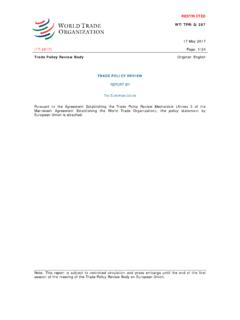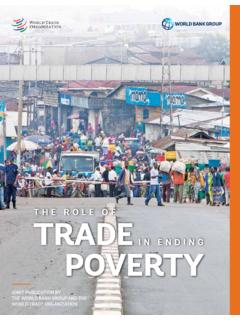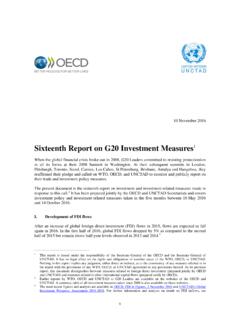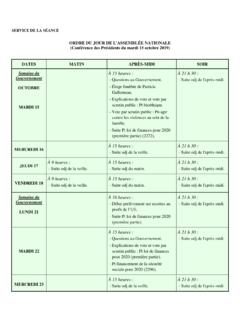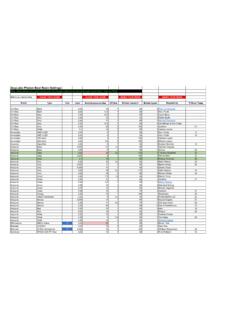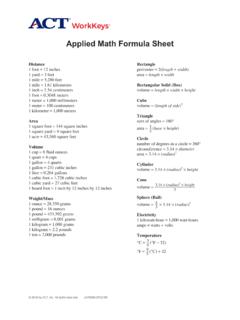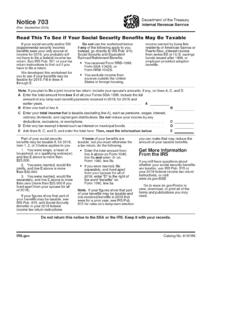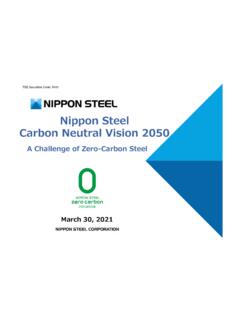Transcription of Applied MFN tariffs
1 WorldTariff Profiles2019 Applied MFN tariffs0 < 22 < 44 < 66 < 88 < 1010 < 1515 < 2020 - m a xThe map on the cover represents the latest available average MFN tariffs Applied by countries/customs territories. These tariffs (in %) are grouped into eight categories. Data are sourced from this publication (covering 2018 and 2017) and from previous publications if more recent data are not available. The boundaries shown on the map do not imply any judgment, official endorsement or acceptance by the WTO as to the legal status or frontier of any this publicationWorld Tariff Profiles is a co-publication of the WTO, ITC and UNCTAD on market access for goods.
2 This annual publication provides comprehensive information on the tariffs and non-tariff measures imposed by over 170 countries and customs territories. Non-WTO members are included if data on the tariffs they Applied in 2018 or 2017 are available in the databases of the WTO, ITC or more informationThe statistical tables included in this report can be downloaded from the WTO web site at ITC UNCTADW orld Tariff Profiles 2019 Download the note and abbreviations 2 Introduction 3I. Summary tables 4 Tarif f 6 Description of column headings 6 Technical notes 7 All products 8 Agricultural products 14 Non-agricultural products 20 Trade 26 Description of column headings 26 Technical notes 27 Imports and exports profile 28II.
3 Country/territory tariff profiles 34 Index of tariff profiles 36 Technical notes 37 Country/territory tariff profiles 42 III. Non-tariff measures 1901. Introduction 1932. Statistics on some selected non-tariff measures Anti-dumping Countervailing measures Safeguards 212IV. Special topic: Aligning trade and tariff policies with sustainable development 218 Aligning trade and tariff policies with sustainable development 220 References 221 Technical Notes 230 Description of column headings 231 Table 1: Tariff and import profiles for goods related to selected SDGs 232V.
4 Annexes 242A. Data sources 244B. Frequently asked questions 249 Acknowledgements 252I SUMMARY TABLESII COUNTRY/TERRITORY TARIFF PROFILESIV SPECIAL TOPICIII NON-TARIFF MEASURESV ANNEXESWTO ITC UNCTADW orld Tariff Profiles 20192 Download the AverageAG Agricultural productsAVE Ad valorem equivalentHS Harmonized System (nomenclature)Max Maximum dutyMFN Most favoured nationNAV Non-ad valorem dutyNon-AG Non agricultural productsSSG Special safeguardsTL Tariff lineUV Unit valueNotations Not applicable0 = 0 (not rounded) > 0 and < = 100 (not rounded) > and < 100 Blank Bound or Applied duties and/or imports are not available at all for a given country or Maxima, based on AVE estimates are printed in italics.
5 This also applies in cases when the ad valorem is part of a compound or mixed duty as ceiling or $ United States dollarGeneral note and abbreviationsThe statistics related to Applied tariffs and imports are calculated using data which are based on the HS nomenclature adopted by the country for the reference year. For statistics on bound tariffs , the calculations are based on the approved schedule of concessions of the WTO member. In previous issues of World Tariff Profiles, each schedule is based on the HS version which the member used when it acceded to the WTO.
6 Starting with the 2010 issue of this publication, bound tariff statistics are based on the approved schedule of concessions for each member in the most recent HS version. This might have some implications on the historical series of various bound tariff indicators affected by the use of a different nomenclature. While the member s commitments have not changed as a result of the transposition, some aggregate statistics might have been affected as a consequence of the change to another HS classification of products into agricultural and non-agricultural is based on Annex 1 of the WTO Agreement on Agriculture which lists all products covered in the Agreement.
7 The Annex enumerates HS codes that are subject to the agriculture negotiations in the WTO and are considered agricultural products. HS codes which are not in Annex 1 are subject to the non-agricultural market access negotiations and are considered non-agricultural the comparison of bound and Applied duties within countries and across countries, the following caveats need to be taken into account besides that of the effects of different HS versions used and nomenclature breakdowns. These are: (1) binding coverage; (2) tariff bindings not fully implemented; and (3) AVEs.
8 While binding commitments cover all agricultural products, in principle, this is not always the case for non-agricultural goods. There are a number of WTO members where the binding coverage for non-agricultural products is less and sometimes much less than 100 per cent. Also, a number of developed countries have not yet fully bound all the tariff lines in their schedules. Any comparison of bound and Applied tariff indicators is only valid in cases of full binding coverage. For most WTO members, except the most recently acceded ones, all commitments dating back to the Uruguay Round have by now been implemented.
9 In cases where commitments are not yet fully implemented, one may see MFN Applied averages or maxima exceeding the corresponding bound duty indicators. Last but not least, the calculation of AVEs may affect the comparison between bound and Applied duties when the changes in nomenclature have resulted in the use of different unit values. In other cases, bound duties have been expressed in a way that is not directly comparable with the currently used Applied duties. In a number of cases, the estimated MFN Applied AVEs were adjusted when the corresponding bound tariff lines were defined in ad valorem terms.
10 In these cases, the corresponding bound ad valorem duty was used as ceiling for the AVE ITC UNCTADW orld Tariff Profiles 2019 Download the World Tariff Profiles is a joint publication of the WTO, ITC and UNCTAD devoted to market access for goods. This statistical yearbook contains a comprehensive compilation of the main tariff parameters for each of the 164 WTO members plus other countries and customs territories where data is available. Each tariff profile presents information on tariffs imposed by each economy on its imports complemented with an analysis of the market access conditions it faces in its major export markets.




